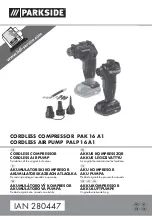
13–11–602 Page 26
Maintenance Adjustments
1.
If any service advisories are in effect (yellow AD-
VISORY indicator is on), they will be displayed on
the top line. The bottom line indicates “LEAVE
ADVISORY” (do not reset) or “CLEAR ADVISO-
RY” (turn it off). Select the desired action and
press [ENTER] to proceed.
2.
The top line displays “NEXT OIL CHANGE” and
the hours remaining are displayed on the bottom
line. Press the [+] or [–] keys to switch to the oil
change interval (see UNIT SETUP) if service was
performed early. Press [ENTER] to proceed.
3.
The top line displays “NEXT OIL FILTER” and the
hours remaining are displayed on the bottom line.
Press the [+] or [–] keys to switch to the oil filter in-
terval (see UNIT SETUP) if service was per-
formed early. Press [ENTER] to proceed.
4.
This completes the maintenance adjustments.
The controller will return to the main adjustments
menu.
Sequence Adjustments
1.
In the top line, “NUM OF SEQ UNITS” is dis-
played. The bottom line will indicate a number in
the range of one through eight. This will be factory
set at “1”. This should be set to a number corre-
sponding to the number of compressors that are
currently installed on this air system that also have
AUTO SENTRY–ES controllers. It should be
noted that all AUTO SENTRY–ES compressors
on the system must have the same number pro-
grammed here to operate correctly in SE-
QUENCE mode.
NOTE: Setting the value in step 1 to one indicates that
no sequencing is to take place. Consequently, steps 2,
3, and 4, which relate to sequencing, are skipped by the
“AUTO SENTRY–ES”; the controller will return to the
main adjustments menu.
2.
In the top line, “UNIT NUMBER” is displayed. The
bottom line will again indicate a number of one
through eight and be factory set at “1”. Each
“AUTO SENTRY–ES” in a sequenced system
must have a unique number here. The sequence
mode will not function if two or more compressors
have the same UNIT NUMBER. Most efficient
machine–to–machine communications will occur
when the lowest possible numbers are used. Ex-
ample: 1, 2, and 3 for a three compressor installa-
tion.
3.
In the top line, “TRANSFER INTERVAL” is dis-
played. The bottom line will indicate a number of
hours in the range of 1 to 5000. It is factory set at
24. This is the number of hours that this machine
will stay in the role of “master” or “lead” compres-
sor. Normally it is desirable to set this to the same
value on all sequenced units to equalize running
hours.
4.
In the top line, “LAG START DELAY” is displayed.
The bottom line will indicate a number in the range
of 15 to 600 seconds. It is factory set at 30. This
is the length of time this machine will wait before
starting when the pressure drops below the reset
point. This should be set to the same value for all
sequenced units. Its setting will depend on the
amount of air storage volume in the system. Too
small a number will result in more compressors
being started than is necessary to satisfy demand.
See “SEQUENCING COMPRESSORS WITH
THE AUTO SENTRY–ES”, page 27, for more de-
tails on optimizing a sequenced installation.
5.
This completes the sequence adjustments. The
controller will return to the main adjustments
menu.
Configuration Adjustments
1.
In the top line, “HI SYS PRES LIM” is displayed.
The bottom line will indicate a value that is factory
set 20 – 25 PSIG (1.4 – 1.7 bar) above name plate.
This is the pressure that will cause a shutdown if
exceeded due to a malfunction such as a stuck in-
let valve or broken control line.
2.
In the top line, “REMOVE SYS PRESS” is dis-
played. The bottom line displays the current pres-
sure being sensed at the package discharge. At
this point steps must be taken to ensure that sys-
tem pressure is, in fact, zero psig. Remove the
line to the system pressure transducer. Pressing
[ENTER] will now cause the “AUTO SENTRY–
ES” to calibrate the transducer output to zero
PSIG. Obviously, pressure measurement errors
will be encountered if ’zeroing’ is done with pres-
sure at the transducer. If large errors are de-
tected, the controller will demand that the trans-
ducer be checked.
3.
In the top line, “REMOVE RES PRESS” is dis-
played. The bottom line displays the current pres-
sure being sensed in the reservoir. The reservoir
pressure transducer may now be ’zeroed’ by fol-
lowing the steps outlined in 2 above.
4.
In the top line, “REMOVE OIL PRESS” is dis-
played. The bottom line displays the current pres-
sure being sensed in the oil line. The oil pressure
transducer may now be ’zeroed’ by following the
steps outlined in 2 above.
5.
This completes the configuration adjustments.
The controller will return to the main adjustments
menu.
Summary of Contents for TWISTAIR EWDQ D
Page 14: ...13 11 602 Page 4 FIGURE 1 6 AIR WATER SCHEMATIC FIGURE 1 7 OIL SCHEMATIC...
Page 17: ...13 11 602 Page 7 DECALS 206EAQ077 212EAQ077 218EAQ077 211EAQ077 207EAQ077...
Page 18: ...13 11 602 Page 8 DECALS 216EAQ077 206EWD077 222EAQ077 221EAQ077 208EAQ077...
Page 35: ...13 11 602 Page 25 FIGURE 4 2 FLOW CHART FOR SET UP PROGRAMMING...
Page 44: ...13 11 602 Page 34 FIGURE 4 6 CONTROL TUBING SCHEMATIC 206EWD797 A Ref Drawing...
Page 48: ...13 11 602 Page 38 FIGURE 4 10 WIRING DIAGRAM FULL VOLTAGE 202EWD546 REF DRAWING...
Page 49: ...13 11 602 Page 39 FIGURE 4 11 WIRING DIAGRAM WYE DELTA 203EWD546 REF DRAWING...
Page 50: ...13 11 602 Page 40 FIGURE 4 12 AUTO SENTRY ES CONTROLLER DISPLAY...
Page 53: ...13 11 602 Page 43 FIGURE 5 2 FLOW DIAGRAM AIR COOLED 202EWD797 B Ref Drawing...
Page 54: ...13 11 602 Page 44 FIGURE 5 3 FLOW DIAGRAM WATER COOLED 203EWD797 A Ref Drawing...
Page 68: ......
















































